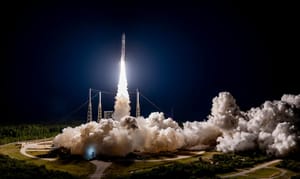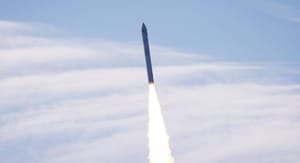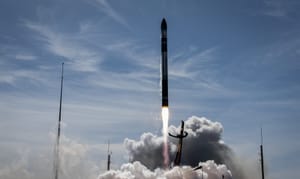
Jan 8, 2024
ULA aces Vulcan-Centaur's first flight!
At 07:18 am on the 8th of January, United Launch Alliance's Vulcan-Centaur rocket lifted off from Space Launch Complex 41, at Cape Canaveral in Florida, for the first time ever!
The rocket delivered Astrobotic's Peregrine lunar lander to its desired orbit for its trip to the Moon, which required the second-stage to light its engines twice. Once Peregrine separated from the second-stage the stage relit for a third time to escape from Earth for safe disposal.
However in a post-launch update, Astrobotic reported that the Peregrine spacecraft was unable to achieve a stable 'sun-pointing orientation' to provide power. Astrobotic's teams are still looking into the situation as it unfolds and is hoping to provide more updates as they obtain more data. The spacecraft is reportedly charging its batteries currently.
The avionics systems, including the primary command and data handling unit, propulsion, thermal, and power controllers, reportedly all powered on and performed as expected prior to teams realizing the orientation issue.

United Launch Alliance's Chief Executive Officer, Tory Bruno, said the following about Vulcan-Centaur's first launch in a post-flight press release:
“Vulcan’s inaugural launch ushers in a new, innovative capability to meet the ever-growing requirements of space launch,” – “Vulcan will provide high performance and affordability while continuing to deliver our superior reliability and orbital precision for all our customers across the national security, civil and commercial markets. Vulcan continues the legacy of Atlas as the world’s only high-energy architecture rocket.”
Tory Bruno also stated the following about the future of Vulcan-Centaur in the same press release:
“As we build on today’s successful launch, the team will continue to work towards our future bi-weekly launch rate to meet our customers’ manifest requirements, while continuing to develop future Vulcan upgrades including SMART reuse plans for downrange, non-propulsive recovery of Vulcan engines”

This mission also served as the first of two certification flights required before flying payloads for the United States Space Force. The next certification flight is expected to fly in April carrying the Dream Chaser spaceplane, built by the Sierra Nevada Corporation, to the International Space Station.
United Launch Alliance has currently sold over seventy launches for Vulcan-Centaur with eleven for the United States Space Force, six for the Sierra Nevada Corporation to carry its Dream Chaser spaceplane, and thirty-eight for Amazon to launch its 'Project Kuiper' satellites. The rest of the payloads flying on Vulcan-Centaur are not yet known publically.
What is the Vulcan-Centaur rocket?
Vulcan-Centaur, sometimes just called Vulcan, is United Launch Alliance's in-development two-stage rocket. Vulcan is planned to replace the company's Atlas V and Delta IV Heavy launch vehicles in the coming decade.
The first-stage is powered by two BE-4 engines generating 500 tons of thrust burning liquid methane and liquid oxygen for four minutes and fifty-nine seconds. Blue Origin manufactures the BE-4 engines for use with United Launch Alliance as well as Blue Origin's upcoming New Glenn rocket.

The second-stage is powered by two RL-10 engines generating 22 tons of thrust burning liquid hydrogen and liquid oxygen for a currently undisclosed amount of time. Aerojet Rocketdyne manufactures the RL-10 engines for use with United Launch Alliance.

Vulcan-Centaur can also launch with either zero, two, four, or six GEM-63XL solid rocket motors to augment the rockets thrust and capabilities. Each booster burns a solid propellant, consisting of Hydroxyl-terminated polybutadiene and Aluminum-Ammonium perchlorate, generating 224 tons of thrust each for a believed one minute and fifty seconds. The solid rocket boosters are manufactured by Northrop Grumman for use with United Launch Alliance.

In the table below, United Launch Alliance claims Vulcan-Centaur can deliver the following amount of payload in its four potential configurations.
| Vulcan Centaur VC0 | 10,800 kilograms to low Earth orbit, 3,500 kilograms to geosynchronous transfer orbit, or 2,300 kilograms to a trans-lunar injection |
| Vulcan Centaur VC2 | 19,000 kilograms to low Earth orbit, 8,400 kilograms to geosynchronous transfer orbit, or 6,300 kilograms to a trans-lunar injection |
| Vulcan Centaur VC4 | 24,600 kilograms to low Earth orbit, 11,700 kilograms to geosynchronous transfer orbit, or 9,200 kilograms to a trans-lunar injection |
| Vulcan Centaur VC6 | 27,200 kilograms to low Earth orbit, 15,300 kilograms to geosynchronous transfer orbit, or 12,100 kilograms to a trans-lunar injection |
The naming scheme of each Vulcan-Centaur configuration is as follows: V stands for Vulcan, C stands for Centaur, 0/2/4/6 stands for the amount of solid rocket motors, and S/L stands for the payload fairing length. For example, Dream Chaser would use the VC4L configuration and Astrobotic's Peregrine lunar lander would use the VC2S configuration.
What's Peregrine, and what's on Peregrine?
Peregrine is Astrobotic's lunar lander designed to carry between 70 and 100 kilograms to the lunar surface while operating for at least eight days. Peregrine will land using five engines burning mono-methyl-hydrazine and dinitrogen tetroxide to generate 0.34 tons of thrust.
The Pergine lunar lander is currently expected to touch down on the Moon on the 23rd of February. This will be the first time Astrobotic lands a spacecraft on the Moon.

Disclaimer: The payload descriptions and missions are as described in Astrobotic's pre-launch press release before its first mission to the Moon.
NIRVSS, Near-Infrared Volatile Spectrometer System, will measure surface and subsurface hydration, carbon dioxide, and methane while also mapping surface temperature and changes at the landing site. It was developed at NASA’s Ames Research Center in Silicon Valley, California.
NSS, Neutron Spectrometer System, will search for indicators of water ice near the lunar surface by measuring how much hydrogen-bearing materials are at the landing site and determining the bulk composition of the regolith there. It was also developed at NASA’s Ames Research Center in Silicon Valley, California.
PITMS, Peregrine Ion-Trap Mass Spectrometer, will characterize the lunar exosphere after descent and landing and throughout the lunar day to understand the release and movement of volatiles. The instrument is a partnership between NASA Goddard Space Flight Center, The Open University, NASA, and the European Space Agency.
NASA's LETS, Linear Energy Transfer Spectrometer, radiation sensor will collect information about the lunar radiation environment and relies on flight-proven hardware that flew on the Orion spacecraft’s inaugural uncrewed flight in 2014. The instrument was developed by NASA's Johnson Space Center.
LRA, Laser Retroreflector Array, is a collection of 1.25-centimeter retroreflectors mounted to the lander. This mirror reflects laser light from other orbiting and landing spacecraft to determine the lander’s position precisely. It was developed by NASA's Goddard Space Flight Center.
NDL, Navigation Doppler Lidar, will determine the Peregrine spacecraft’s exact
velocity and position to land on the Moon using LiDAR, light detection, and ranging. The instrument was developed by NASA's Langley Research Center.
LINX-UNAM will fly the first Latin American scientific instrument to the surface of the Moon. Consisting of 5 small rovers each weighing roughly 60 grams and measuring 12 centimeters across, the miniature rovers will demonstrate autonomous and coordinated exploration of the lunar surface.
Astrobotic will demonstrate its standalone TRN, Terrain Relative Navigation, sensor as a payload on its first mission to the Moon. TRN will enable spacecraft to perform landings on planetary surfaces with an unparalleled accuracy of less than 100 meters. The TRN sensor is being developed under NASA's Tipping Point contract.
Astroscale will send the Pocari Sweat Lunar Dream time capsule to the Moon, which contains 185,872 messages from children from around the world.
Carnegie Mellon University, CMU, students, staff, and professors collaborate with Astrobotic to develop space robotics technology. Carnegie Mellon University is currently developing the Iris rover for Astrobotic’s inaugural lunar mission.
The MoonArk, is a collaborative space project at Carnegie Mellon University, embodying the arts, humanities, sciences, and technologies in a set of intricately designed objects intended to spark wonderment and discovery for future generations.
Elysium Space is reportedly providing lunar memorial services to deliver a symbolic portion of remains to the surface of the Moon.
The German Aerospace Center, or DLR, is flying the M-42 radiation detector scientific experiment. The sensors will precisely measure the level of radiation a human body will encounter on a trip to the Moon and back.
Lunar Mission One will send the first digital storage payloads to the Moon. The payload will support Lunar Mission One’s 'Footsteps on the Moon' campaign.
Puli Space Technologies will send a unique plaque for the 'Memory of Mankind on the Moon' project. The plaque contains archival imagery and texts readable with a 10x magnifier.
Astrobotic reportedly also accepted small personal mementos for inclusion on Peregrine Mission One. 'Moon Capsules' containing payloads from around the world will be stored aboard Peregrine on the Moon for centuries to come.
Who is Astrobotic?
Astrobotic is a worker-owned space company that develops advanced navigation, operation, power, testing, and computing systems for spacecraft. Astrobotic was founded in 2007 and has headquarters in both Mojave, California, and Pittsburgh, Pennsylvania.

Who is United Launch Alliance?
United Launch Alliance is an American aerospace company founded in December of 2006 as a joint venture between Lockheed Martin and Boeing. The company currently operates the Delta IV Heavy, Atlas V, and Vulcan-Centaur launch vehicles.




